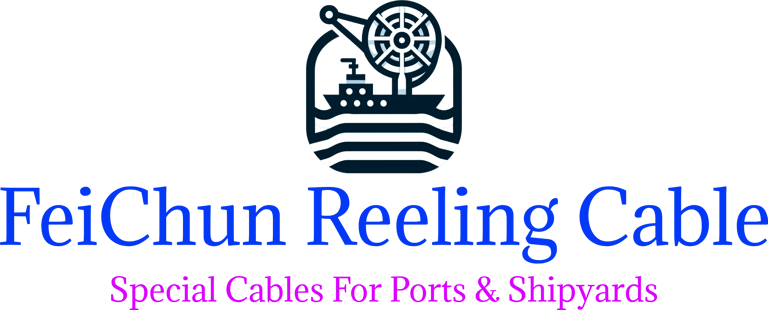Type 3TC-RB (3PNCT) Reeling Rubber Cable: Engineered for Dynamic Industrial Excellence
Discover the Type 3TC-RB (3PNCT) Reeling Rubber Cable—engineered for dynamic industrial applications. Compliant with JIS C 3327, featuring EP rubber insulation and a reinforced polychloroprene sheath for superior durability and flexibility. Ideal for curtain systems, carrier drums, and cableveyor methods.
Type 3TC-RB (3PNCT) Reeling Rubber Cable: Engineered for Dynamic Industrial Excellence
Explore the robust design and superior performance of the Type 3TC-RB (3PNCT) Reeling Rubber Cable. Learn about its compliance with JIS C 3327, unique structural features, and best practices for installation and maintenance in dynamic industrial environments.
1. Introduction: The Backbone of Dynamic Industrial Applications
In the demanding world of industrial operations, certain cable systems must endure constant motion, retraction, and flexing while maintaining flawless performance. Reeling cables represent the unsung heroes of these dynamic environments, functioning reliably despite daily mechanical stress that would quickly deteriorate standard cabling. At the intersection of engineering excellence and practical durability stands the Type 3TC-RB (3PNCT) Reeling Rubber Cable—a purpose-built solution for industries where movement and flexibility aren't occasional requirements but constant necessities.
From theater rigging systems that transform performance spaces within seconds to massive gantry cranes that power global shipping operations, these specialized cables provide the electrical lifeline that makes modern industrial motion possible. The 3TC-RB cable isn't merely designed to survive in these environments—it's engineered to thrive, delivering consistent performance even under punishing operational conditions that combine mechanical stress with environmental challenges.
2. Compliance and Standards
At the foundation of the 3TC-RB's reliability lies its strict adherence to JIS C 3327, the Japanese Industrial Standard governing rubber-insulated flexible cables for dynamic applications. This compliance isn't merely bureaucratic box-checking—it represents a comprehensive verification of the cable's performance across multiple critical parameters.
The JIS C 3327 standard establishes rigorous benchmarks for mechanical durability, electrical integrity under stress, flame resistance, and long-term reliability. By meeting these exacting requirements, the 3TC-RB cable provides operations managers and engineers with documented assurance that their electrical systems will perform reliably even in the most demanding industrial contexts.
This compliance matters particularly in high-stakes applications where cable failure could result in costly downtime, safety hazards, or cascading operational failures. The standard's testing protocols simulate years of real-world punishment in compressed timeframes, ensuring that compliant cables like the 3TC-RB will deliver their specified performance throughout their service life.
3. Structural Composition and Materials
The exceptional performance of the 3TC-RB cable stems directly from its sophisticated multi-layer construction, with each component engineered to address specific operational challenges:
Conductor: The cable utilizes tin-coated annealed copper strand wire as its foundational conductive element. This isn't merely ordinary copper—the tin coating provides superior corrosion resistance, particularly important in humid environments or applications involving frequent temperature changes that could otherwise lead to oxidation. The stranded configuration offers excellent flexibility while maintaining optimal electrical conductivity, ensuring minimal power loss even during constant movement.
Insulation: Surrounding each conductor, a precisely formulated ethylene propylene rubber (EP rubber) layer provides dielectric protection with remarkable thermal stability. This EP rubber maintains its insulating properties across a wide temperature range from -40°C to 90°C, significantly outperforming PVC alternatives in extreme environments. The material's inherent elasticity allows it to flex millions of times without developing the microcracks that often lead to insulation failure in lesser cables.
Sheath: The polychloroprene rubber outer sheath represents the cable's first line of defense against the outside world. This specialized synthetic rubber delivers an exceptional combination of oil resistance, chemical immunity, UV stability, and mechanical toughness. When industrial lubricants splash onto the cable or it's exposed to harsh cleaning solvents, the polychloroprene maintains its structural integrity while preventing these potentially damaging substances from reaching the internal components.
Reinforcement Layer: Perhaps the most distinctive feature of the 3TC-RB design is its integrated mid-sheath reinforcement layer. This structural element distributes mechanical stresses throughout the cable assembly rather than allowing them to concentrate at vulnerable points. The reinforcement dramatically enhances the cable's tensile strength and impact resistance while maintaining the flexibility essential for reeling applications.
Together, these carefully selected materials and structural elements create a cable that consistently outperforms conventional designs in the most punishing operational environments.
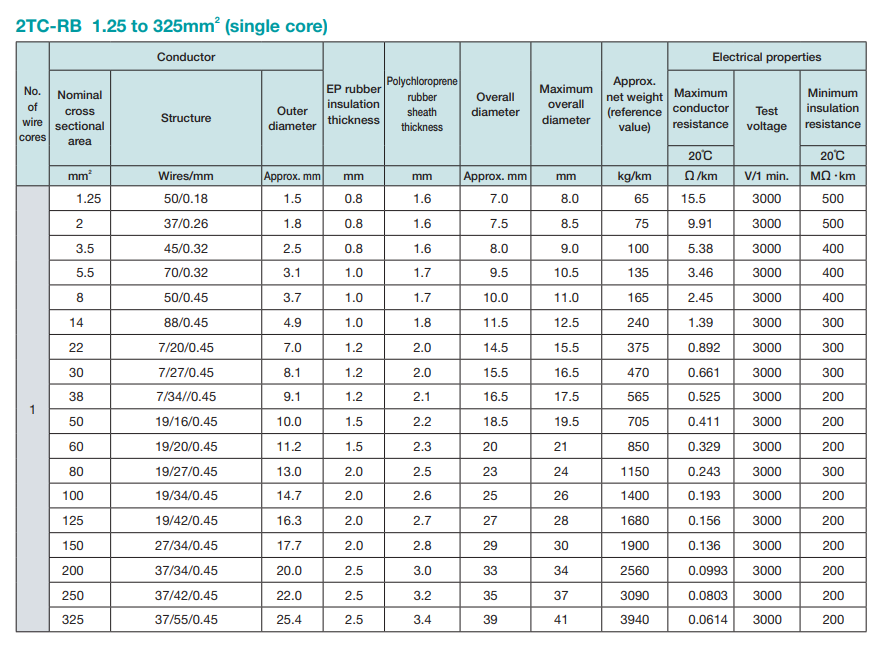

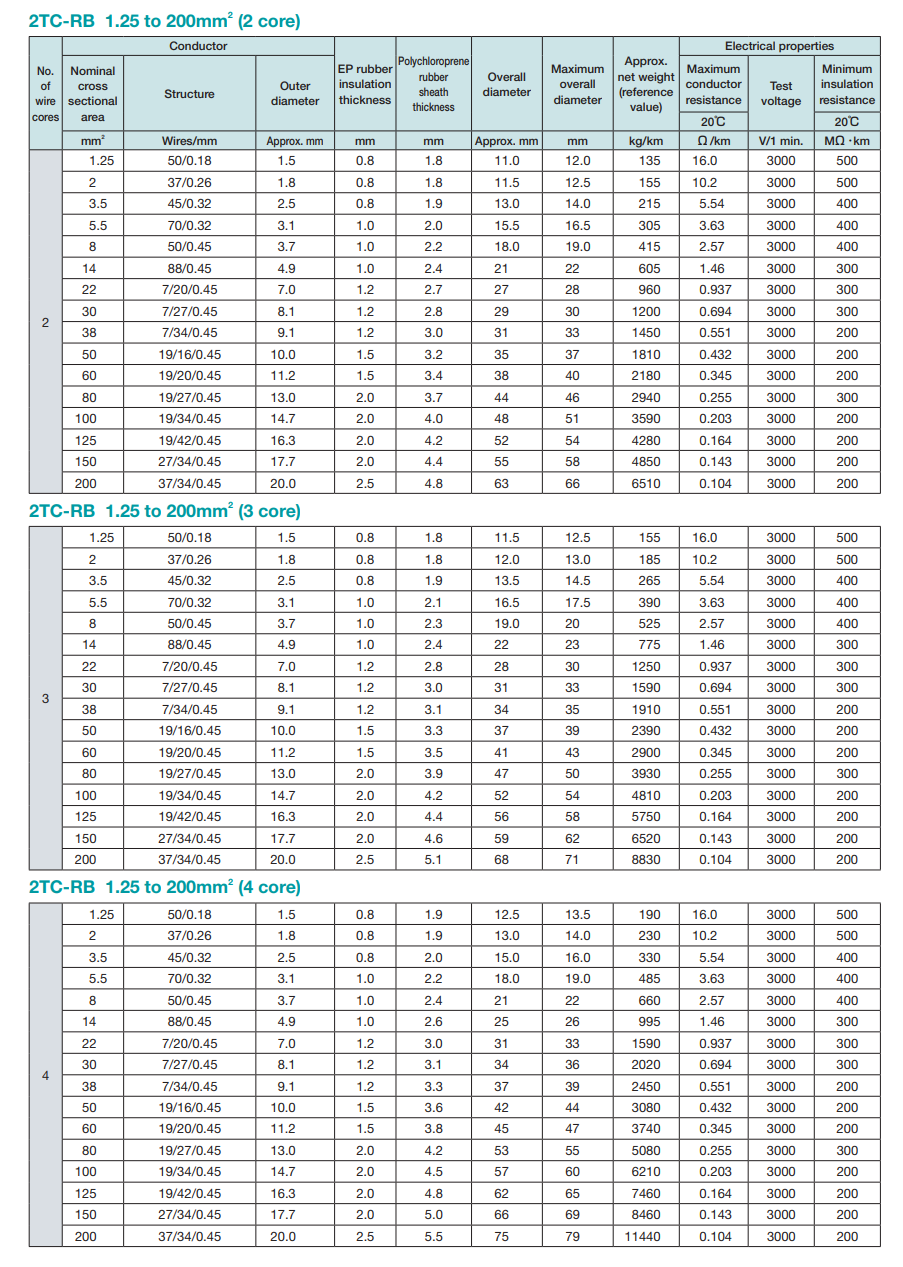

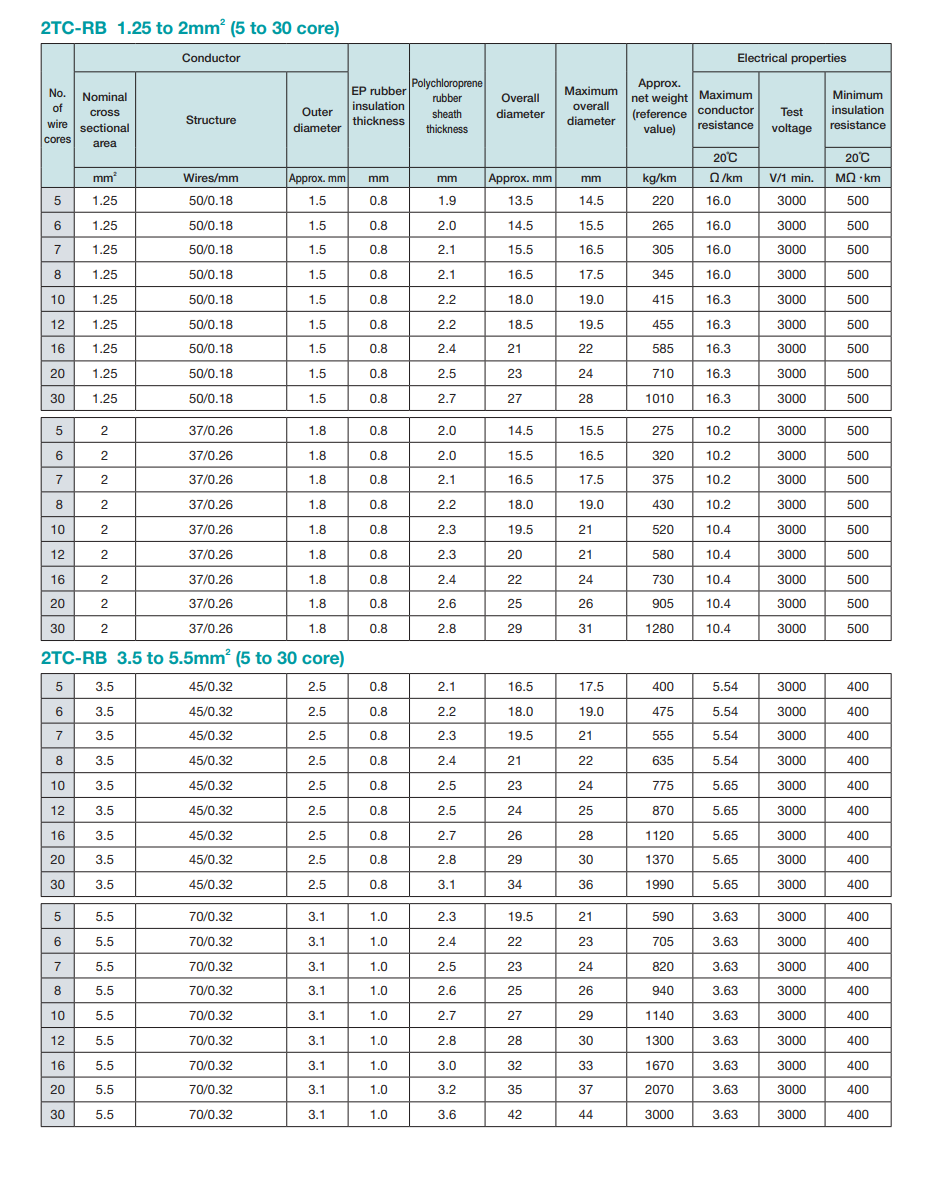

4. Core Identification and Configuration
Proper core identification represents a crucial but often overlooked aspect of industrial cable design. The 3TC-RB implements a systematic color-coding approach that streamlines installation and maintenance operations:
For 2-core configurations, the cable utilizes a straightforward Black and White coloring scheme, with Black typically designated for the live conductor and White for neutral.
In 3-core versions, the standard Black and White conductors are joined by a Red core, commonly used for the second phase in three-phase systems or as a dedicated ground/earth connection in certain applications.
The 4-core configuration extends this system with Black, White, Red, and Green conductors, facilitating complete three-phase with ground installations or other multi-conductor requirements.
For cables with 5 cores or more, the 3TC-RB employs a sophisticated tracer method that combines base colors with distinctive marking patterns, allowing technicians to easily distinguish between dozens of conductors without confusion.
This thoughtful identification system dramatically reduces the possibility of connection errors during installation and enables faster troubleshooting during maintenance operations. When technicians can instantly identify specific conductors without time-consuming continuity testing, system downtime diminishes and operational efficiency improves.
5. Key Features and Advantages
The 3TC-RB cable's unique design translates into several concrete operational advantages that directly impact industrial performance and reliability:
Extraordinary Flexibility and Durability: The stranded conductors, elastic EP rubber insulation, and reinforced construction work together to enable exceptional flexibility without compromising electrical integrity. Where conventional cables would develop fatigue cracks after several thousand flexing cycles, the 3TC-RB can withstand millions of bending operations while maintaining perfect conductivity—a critical factor in applications where the cable is constantly moving.
Superior Mechanical Resilience: The integrated reinforcement layer transforms what would otherwise be a vulnerability into a strength. When subjected to tension, compression, or impact, the reinforcement distributes mechanical energy throughout the cable structure rather than allowing it to concentrate at specific points. This characteristic dramatically reduces the risk of internal damage during normal operation.
Environmental Immunity: Industrial environments rarely remain clean and controlled. Oil spray from machinery, chemical mists from manufacturing processes, UV exposure from outdoor installations, and temperature extremes from process heat all threaten cable integrity. The polychloroprene sheath provides exceptional resistance to these environmental challenges, maintaining its protective properties even after years of exposure.
Enhanced Safety Profile: Beyond operational reliability, the 3TC-RB prioritizes safety through inherent flame-retardant properties. If exposed to fire, the cable's specialized materials self-extinguish rather than propagating flames—a critical characteristic in industrial environments where fire hazards could have catastrophic consequences.
These performance advantages combine to create a cable that doesn't merely meet specifications but consistently exceeds operational expectations in the most demanding industrial applications.
6. Typical Applications
The 3TC-RB cable's unique performance characteristics make it ideally suited for several specialized industrial applications:
Theater and Performance Curtain Systems: Modern theatrical productions rely on sophisticated automated curtain systems that must operate silently, reliably, and often at high speeds. The 3TC-RB's exceptional flexibility and noiseless operation make it ideal for these applications, where mechanical sound during scene changes would disrupt performances.
Crane and Hoist Carrier Drum Systems: In shipyards, manufacturing facilities, and logistics centers, carrier drum systems on cranes continuously reel cables in and out as the equipment moves. These applications combine extreme mechanical stress with exposure to industrial environments, conditions where the 3TC-RB's reinforced design and environmental resistance prove invaluable.
Cableveyor Systems in Automated Manufacturing: Modern production lines feature robotic systems that perform repetitive movements thousands of times daily, with cables flexing with each cycle. The 3TC-RB's high flex-life makes it perfectly suited for these cableveyor systems, reducing maintenance requirements and preventing costly production interruptions.
Material Handling Equipment: From mining operations to recycling facilities, material handling equipment operates continuously in harsh conditions full of dust, vibration, and mechanical impacts. The 3TC-RB's robust construction ensures reliable power delivery even in these punishing environments.
In each of these applications, the cable's failure would result in significant operational disruption and potentially substantial financial losses. The 3TC-RB's engineered reliability transforms a potential weak link in industrial systems into a dependable component that matches the durability of the equipment it powers.
7. Installation Best Practices
Even the most perfectly engineered cable requires proper installation to deliver its full performance potential. For optimal results with the 3TC-RB, industry professionals should observe these installation guidelines:
Maintain Appropriate Bending Radius: Despite its exceptional flexibility, the 3TC-RB still requires adherence to minimum bending radius specifications to prevent internal damage. As a general rule, maintain a minimum bending radius of 6 times the cable's overall diameter for dynamic applications and 4 times the diameter for fixed installations. This ensures the internal conductors and reinforcement structures aren't subjected to excessive stress during operation.
Implement Proper Support Structures: In reeling applications, the cable should be supported at regular intervals to prevent excessive tensile stress. Cable carriers, festoon systems, or properly designed reels should distribute the cable's weight evenly and prevent localized stress points from developing. Pay particular attention to transition points where the cable moves from fixed to dynamic sections.
Consider Environmental Factors: While the 3TC-RB offers excellent environmental resistance, installation planning should still minimize exposure to extreme conditions. Where possible, position reeling systems away from direct contact with lubricants, process chemicals, or extreme heat sources. When such exposure is unavoidable, implement regular inspection schedules to monitor for any signs of accelerated wear.
Execute Proper Terminations: The termination points often represent the most vulnerable sections of any cable installation. When connecting the 3TC-RB to equipment, ensure strain relief devices transfer mechanical forces to the cable's reinforced sections rather than to the conductors themselves. Use appropriately sized connectors and ensure proper crimping or termination techniques that don't compromise the cable's environmental sealing.
Verify Operational Parameters: Before commissioning any system using the 3TC-RB, verify that the operational parameters (speed of movement, duty cycle, environmental exposure) align with the cable's specifications. Even the most robust cable can fail prematurely if operated beyond its design parameters.
Following these installation best practices ensures the 3TC-RB will deliver its full performance potential throughout its service life, maximizing return on investment and minimizing operational interruptions.
8. Maintenance and Inspection
Proactive maintenance significantly extends the service life of the 3TC-RB cable and prevents unexpected failures that could disrupt operations. An effective maintenance program includes:
Regular Visual Inspections: Establish a consistent schedule for visual examination of exposed cable sections, looking for signs of mechanical damage, sheath abrasion, or environmental deterioration. Pay particular attention to areas where the cable experiences the most movement or environmental stress. Even minor visible damage can indicate developing problems that could lead to failure if left unaddressed.
Movement Pattern Analysis: Periodically observe the cable during operation to ensure it moves freely without catching, kinking, or experiencing unnecessary stress. Improper movement patterns often indicate issues with support structures or developing problems within the cable itself.
Electrical Testing: Beyond visual inspection, implement regular electrical testing to verify the cable maintains proper insulation resistance and conductor continuity. Modern testing equipment can detect developing issues before they manifest as operational failures, allowing for scheduled maintenance rather than emergency repairs.
Recognition of Warning Signs: Train maintenance personnel to recognize early indicators of potential cable problems, including:
Unusual stiffness in previously flexible sections
Visible discoloration of the outer sheath
Minor cuts or abrasions that penetrate the outer layer
Abnormal noise during cable movement
Intermittent electrical performance issues
Cleaning Protocols: In environments with significant dust, oil, or chemical exposure, implement regular cleaning of the cable using manufacturer-approved methods. Accumulated contaminants can accelerate wear or mask developing problems during visual inspections.
This comprehensive maintenance approach transforms cable management from a reactive to a proactive process, significantly reducing the risk of unexpected failures and extending the operational life of the 3TC-RB well beyond standard expectations.
9. Environmental Considerations
Beyond its operational advantages, the 3TC-RB cable offers several environmental benefits worth considering in an era of increasing sustainability focus:
Extended Service Life: Perhaps the most significant environmental benefit comes from the cable's exceptional durability. By lasting significantly longer than standard cables in demanding applications, the 3TC-RB reduces waste generation and conserves the raw materials and energy that would otherwise be required for frequent replacements. Some installations report service life extensions of 300-400% compared to conventional cables in identical applications.
Material Selection: The cable's primary materials—copper, rubber compounds, and reinforcement elements—can be effectively separated and recycled at end-of-life. The polychloroprene sheath, while offering excellent performance, can be processed through specialized recycling programs rather than requiring landfill disposal.
Operational Efficiency: The cable's optimized electrical performance contributes to system-wide energy efficiency. Lower resistance means reduced power loss during operation, translating to marginally lower energy consumption over the installation's lifetime—a small but meaningful contribution to operational sustainability.
Responsible Disposal: When the cable eventually reaches end-of-life, working with specialized industrial recyclers ensures maximum material recovery. Many components, particularly the copper conductors, retain significant value that can offset recycling costs while diverting materials from waste streams.
While industrial cable selection might not seem an obvious focus for environmental initiatives, the cumulative impact of choosing durable, recyclable products like the 3TC-RB can contribute meaningfully to sustainability goals when implemented across large operations.
10. Conclusion: Investing in Reliability and Performance
In dynamic industrial applications where continuous motion and flexibility are operational requirements, the quality of reeling cables directly impacts overall system reliability, maintenance costs, and long-term performance. The Type 3TC-RB (3PNCT) cable represents an engineered solution specifically designed for these demanding environments, delivering exceptional durability where conventional cables would quickly fail.
The cable's sophisticated construction—combining tin-coated copper conductors, EP rubber insulation, reinforcement layers, and a protective polychloroprene sheath—creates a component capable of withstanding millions of flex cycles while maintaining perfect electrical characteristics. This performance isn't merely theoretical; it's guaranteed through compliance with the rigorous JIS C 3327 standard that validates the cable's capabilities through standardized testing.
For operations managers, maintenance engineers, and system designers working with dynamic equipment, the 3TC-RB offers a rare opportunity to eliminate a common failure point through appropriate component selection. While the initial investment may exceed that of standard cables, the dramatic reduction in maintenance requirements and operational interruptions delivers compelling total cost of ownership advantages over the installation's lifetime.
In industrial environments where reliability isn't merely desirable but essential, the Type 3TC-RB (3PNCT) Reeling Rubber Cable provides the performance foundation that demanding applications require. By selecting this purpose-engineered solution, operations can ensure their electrical distribution systems match the durability and reliability of the equipment they power—transforming a potential weakness into a dependable strength.


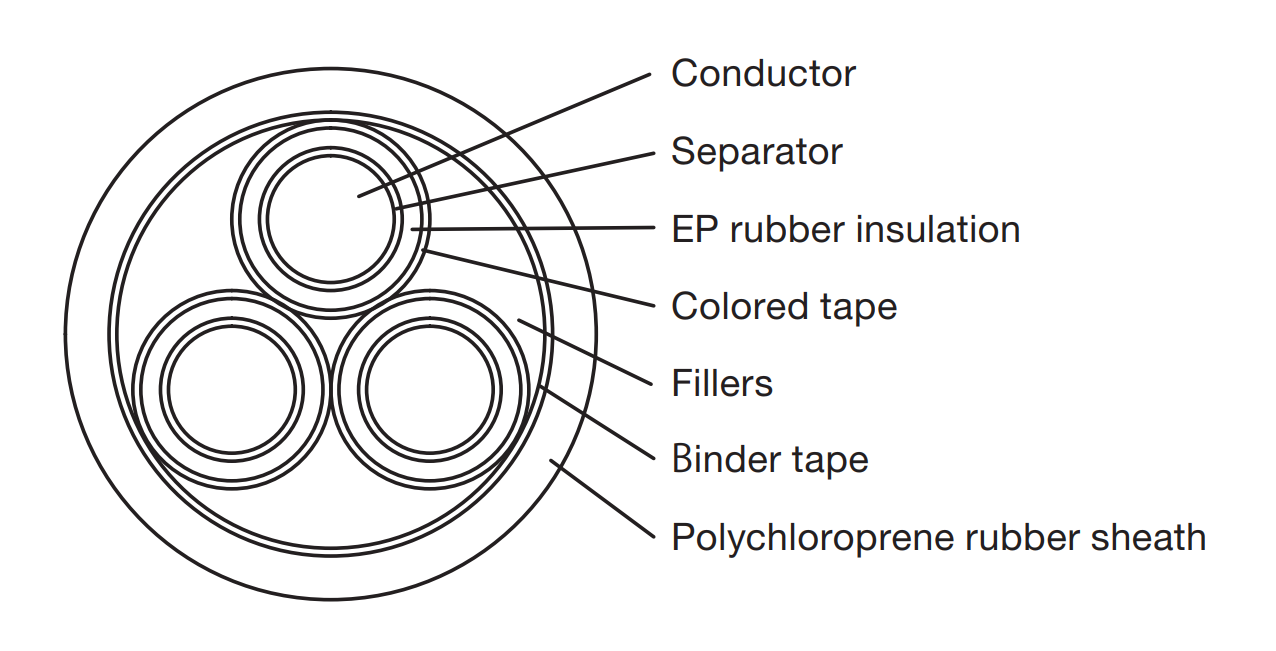

Frequently Asked Questions (FAQ)
General Information
What is the Type 3TC-RB (3PNCT) Reeling Rubber Cable?
It's a Class 3, 600V rubber-insulated cable designed for dynamic applications requiring frequent flexing, such as in curtain systems and cableveyor methods.What does "3PNCT" stand for?
"3PNCT" refers to a three-core Polyvinyl Chloride-insulated, Neoprene-sheathed Cabtyre cable, indicating its construction and insulation materials.Which standards does this cable comply with?
It complies with JIS C 3327, ensuring it meets Japanese Industrial Standards for rubber-insulated cables.What are the primary applications for this cable?
It's used in dynamic industrial settings like curtain systems, carrier drums, and cableveyor methods, where flexibility and durability are essential.What voltage rating does this cable have?
The cable is rated for 600V, suitable for low-voltage power applications.
Construction & Materials
What type of conductor is used?
Tin-coated annealed copper strand wire, offering excellent conductivity and corrosion resistance.What insulation material is utilized?
Ethylene Propylene Rubber (EP rubber), known for its flexibility and thermal stability.What is the sheath made of?
Polychloroprene rubber, providing resistance to oils, chemicals, and environmental factors.Is there a reinforcement layer?
Yes, a reinforced layer midway through the sheath enhances resistance to external damage and impact.How are the wire cores identified?
Color coding: 2-core (Black, White), 3-core (Black, White, Red), 4-core (Black, White, Red, Green), 5-core or higher uses a tracer method.
Performance & Durability
How does the cable perform under mechanical stress?
The reinforced sheath and flexible insulation allow it to withstand frequent bending and reeling without degradation.Is the cable resistant to environmental factors?
Yes, the sheath provides excellent resistance to oils, chemicals, UV radiation, and temperature variations.What is the operating temperature range?
Typically, -40°C to +90°C, depending on specific installation conditions.Does the cable have flame-retardant properties?
Yes, the materials used are inherently flame-retardant, enhancing safety in industrial environments.What is the expected service life?
With proper installation and maintenance, the cable offers a long service life, even in demanding applications.
Installation & Handling
What is the minimum bending radius?
Generally, six times the cable's outer diameter, but always refer to manufacturer guidelines for specific values.Can the cable be used in vertical installations?
Yes, it's suitable for both horizontal and vertical applications, including vertical reel winding methods.Is special equipment needed for installation?
Standard cable handling equipment is sufficient, but care should be taken to avoid twisting and excessive tension.Can the cable be used outdoors?
Yes, the sheath's resistance to UV and environmental factors makes it suitable for outdoor use.Are there specific installation precautions?
Avoid exceeding the bending radius, prevent twisting, and ensure proper support to maintain cable integrity.
Maintenance & Safety
How should the cable be maintained?
Regular inspections for wear, proper tension, and environmental damage are recommended to ensure longevity.What are signs of cable wear?
Cracks in the sheath, discoloration, stiffness, or exposed conductors indicate potential issues.Is the cable safe in high-temperature environments?
Yes, within its specified operating temperature range, it maintains performance and safety.Can the cable be repaired if damaged?
Minor sheath damages can sometimes be repaired, but significant damage may require cable replacement.Does the cable emit toxic fumes when burned?
The materials are designed to be flame-retardant and minimize toxic emissions, but burning any cable should be avoided.
Technical Specifications
What is the conductor resistance?
Resistance varies by size; for example, a 3.5mm² conductor typically has a resistance of 5.38 Ω/km at 20°C.What is the insulation resistance?
Minimum insulation resistance is generally 500 MΩ·km at 20°C, ensuring electrical safety.What is the test voltage?
The cable is tested at 3000V for one minute to ensure insulation integrity.What sizes are available?
Sizes range from 1.25mm² to 325mm², accommodating various current requirements.What is the approximate weight?
Weight depends on size; for instance, a 3.5mm² cable weighs approximately 90 kg/km.
Environmental & Compliance
Is the cable environmentally friendly?
While designed for durability, proper disposal and recycling practices should be followed to minimize environmental impact.Does it meet international standards?
Primarily designed to meet JIS C 3327, but it may also comply with other international standards; verify with the manufacturer.Is the cable recyclable?
Components like copper conductors can be recycled; consult local regulations for proper disposal methods.Does the cable contain hazardous substances?
It is manufactured to comply with safety standards, minimizing hazardous substances; always refer to the material safety data sheet (MSDS).Can the cable be used in cleanroom environments?
While not specifically designed for cleanrooms, its low outgassing materials may be suitable; consult with the manufacturer for confirmation.
Type 3TC-RB (3PNCT) Reeling Rubber Cable: Engineered for Dynamic Industrial Excellence
Discover the Type 3TC-RB (3PNCT) Reeling Rubber Cable—engineered for dynamic industrial applications. Compliant with JIS C 3327, featuring EP rubber insulation and a reinforced polychloroprene sheath for superior durability and flexibility. Ideal for curtain systems, carrier drums, and cableveyor methods.
5/1/202513 min read
